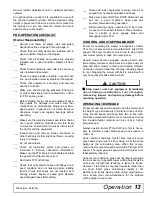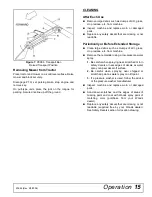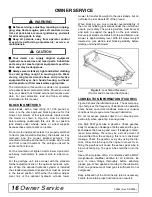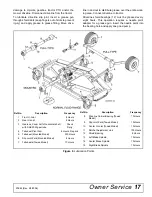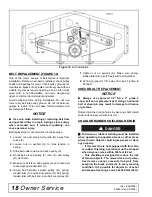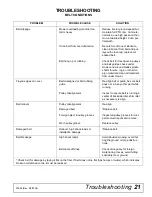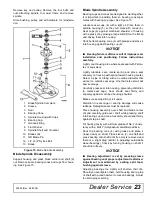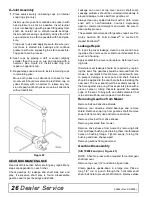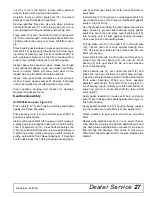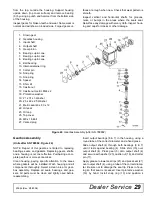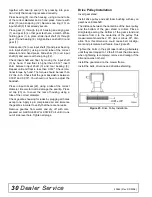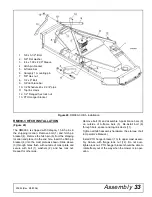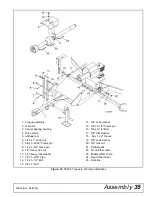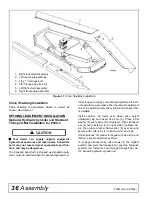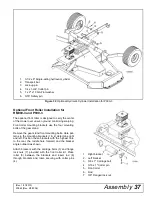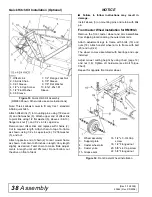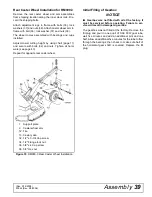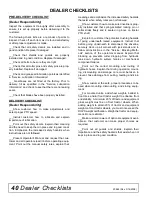
Dealer Service 27
20944 (Rev. 2/3/2006)
nut (19). If nut is too tight to remove with a spanner
wrench, loosen with a punch and hammer.
Carefully remove vertical shaft seal (18) to prevent
damage to shaft threads and seal bore.
Remove gearbox from vise. Use care when removing
horizontal shaft seal (1) and retaining ring (2) to pre-
vent damage to shaft seal surface and housing bore.
Place puller (20) over horizontal shaft (6) and insert a
1/2" bolt or rod through horizontal shaft shear bolt hole.
Tighten puller bolts evenly to remove shaft from hous-
ing.
Place housing upside-down in a press and remove ver-
tical shaft (14) by pressing through the top of the hous-
ing. Remove bearing cone (15) from vertical shaft (14)
with a spreader. Remove all cups from housing with a
puller or by carefully driving them out with a punch.
Inspect gears for excessive wear. Gears are forged
and surfaces will appear rough, even when new. Some
wear is normal. Gears will show more wear on the
loaded side and the pattern should be smooth.
Inspect both gear shafts and stake nut for grooves,
nicks or bumps where seals seat. Replace if damage
cannot be repaired by resurfacing with emery cloth.
Clean gearbox housing and inspect for damage.
Replace if cracks are found.
Gearbox Assembly
(S/N 788882 and prior, Figure 23)
Press cups (8 & 16) into housing until they seat tightly
against machined shoulders.
Press bearing cone (15) onto vertical gear shaft (14)
and seat it against gear.
Insert vertical gear shaft into housing. Invert housing in
a press and place supports under gear to hold bearing
cone (15) against cup (16). Press bottom bearing cone
(15) onto shaft until all free play is removed and there is
a slight drag when rotating housing on shaft (similar to
setting automobile front wheel bearings). If bearings
are too tight, loosen by holding housing and rapping on
end of vertical gear shaft (14) with a shot hammer or
equivalent.
Install O-ring (17) into groove on vertical gear shaft (14)
next to bearing cone (15). Place a small bead of gasket
sealer on top of O-ring.
Use the proper size tubing to press against the outside
edge of seal to prevent seal damage. Apply gasket
sealant to seal bore and press output shaft seal (18)
into housing until it seats against housing shoulder.
Coat inner portion of seal with grease.
Thread stake nut (19) onto shaft (14) in through seal
(18). Tighten until nut is snug against bearing cone
(15). Use a punch to stake the lip of stake nut (19) into
shaft (14) keyway.
Insert shaft (6) through top of housing out through hori-
zontal hole, then set bearing (7) into cup (8). Press
bearing (5) onto gear shaft (6). Do not use excessive
force to seat bearing.
Place bearing cup (4) over horizontal shaft (6) and
press into housing until there is a slight drag on bear-
ings when shaft is rotated (similar to setting automobile
front wheel bearings). When you have bearings
adjusted, select shims from shim kit (3) and place on
top of bearing cup (4) until they are flush with bottom of
snap ring groove in horizontal shaft (6), then install
snap ring (2).
Apply gasket sealant to housing seal bore and press
seal (1) into housing until it seats against snap ring or is
flush with housing.
Apply gasket sealant to top of housing flange, replace
top cover and secure with bolts (10) and washers (9).
Attach gearbox to gear stand and torque mounting
bolts.
Remove the dipstick and pour in one quart of gear
lube. Wait five minutes and add an additional pint and
one half. Allow an additional five minutes for the lube to
flow through the bearings, then check to make sure
half of the horizontal gear shaft is covered. Replace the
dipstick.

